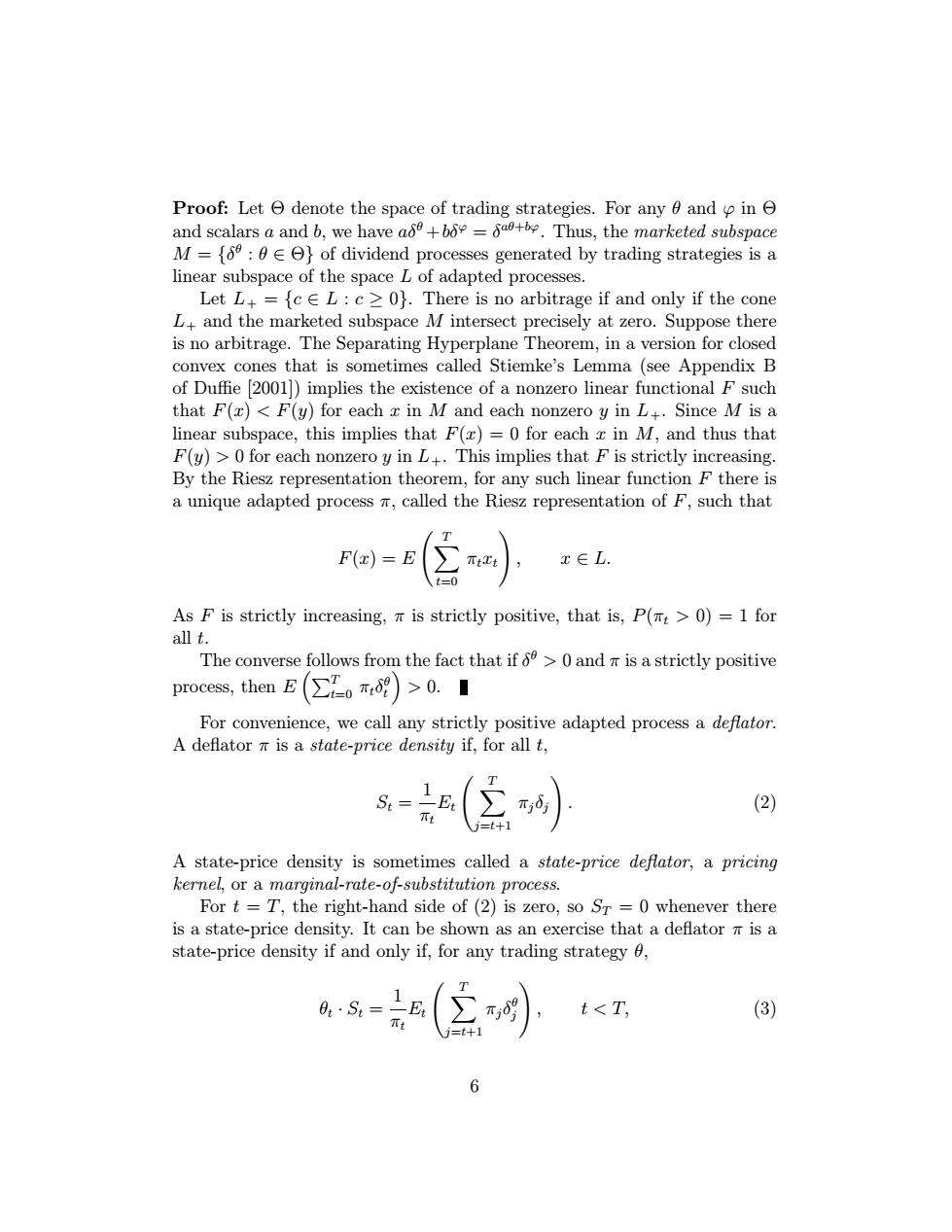正在加载图片...

Proof:Let e denote the space of trading strategies.For any 0 and in and scalars a and b,we have a+b=8+.Thus,the marketed subspace M=f8o:0e}of dividend processes generated by trading strategies is a linear subspace of the space L of adapted processes. Let L+=fcL:c>0.There is no arbitrage if and only if the cone L+and the marketed subspace M intersect precisely at zero.Suppose there is no arbitrage.The Separating Hyperplane Theorem,in a version for closed convex cones that is sometimes called Stiemke's Lemma (see Appendix B of Duffie [2001)implies the existence of a nonzero linear functional F such that F(x)<F(y)for each x in M and each nonzero y in L+.Since M is a linear subspace,this implies that F(x)=0 for each x in M,and thus that F(y)>0 for each nonzero y in L+.This implies that F is strictly increasing. By the Riesz representation theorem,for any such linear function F there is a unique adapted process m,called the Riesz representation of F,such that F(z) x∈L. As F is strictly increasing,m is strictly positive,that is,P(m>0)=1 for all t. The converse follows from the fact that if >0 and m is a strictly positive process,then0. For convenience,we call any strictly positive adapted process a deflator. A deflator n is a state-price density if,for all t, St= (2) i= A state-price density is sometimes called a state-price deflator,a pricing kernel,or a marginal-rate-of-substitution process. For t =T,the right-hand side of(2)is zero,so ST=0 whenever there is a state-price density.It can be shown as an exercise that a deflator m is a state-price density if and only if,for any trading strategy 0, 0·S= t<T, (3) 6Proof: Let Θ denote the space of trading strategies. For any θ and ϕ in Θ and scalars a and b, we have aδθ +bδϕ = δaθ+bϕ. Thus, the marketed subspace M = {δθ : θ ∈ Θ} of dividend processes generated by trading strategies is a linear subspace of the space L of adapted processes. Let L+ = {c ∈ L : c ≥ 0}. There is no arbitrage if and only if the cone L+ and the marketed subspace M intersect precisely at zero. Suppose there is no arbitrage. The Separating Hyperplane Theorem, in a version for closed convex cones that is sometimes called Stiemke’s Lemma (see Appendix B of Duffie [2001]) implies the existence of a nonzero linear functional F such that F(x) < F(y) for each x in M and each nonzero y in L+. Since M is a linear subspace, this implies that F(x) = 0 for each x in M, and thus that F(y) > 0 for each nonzero y in L+. This implies that F is strictly increasing. By the Riesz representation theorem, for any such linear function F there is a unique adapted process π, called the Riesz representation of F, such that F(x) = E X T t=0 πtxt ! , x ∈ L. As F is strictly increasing, π is strictly positive, that is, P(πt > 0) = 1 for all t. The converse follows from the fact that if δθ > 0 and π is a strictly positive process, then E PT t=0 πtδθ t > 0. For convenience, we call any strictly positive adapted process a deflator. A deflator π is a state-price density if, for all t, St = 1 πt Et X T j=t+1 πjδj ! . (2) A state-price density is sometimes called a state-price deflator, a pricing kernel, or a marginal-rate-of-substitution process. For t = T, the right-hand side of (2) is zero, so ST = 0 whenever there is a state-price density. It can be shown as an exercise that a deflator π is a state-price density if and only if, for any trading strategy θ, θt · St = 1 πt Et X T j=t+1 πjδθ j ! , t < T, (3) 6